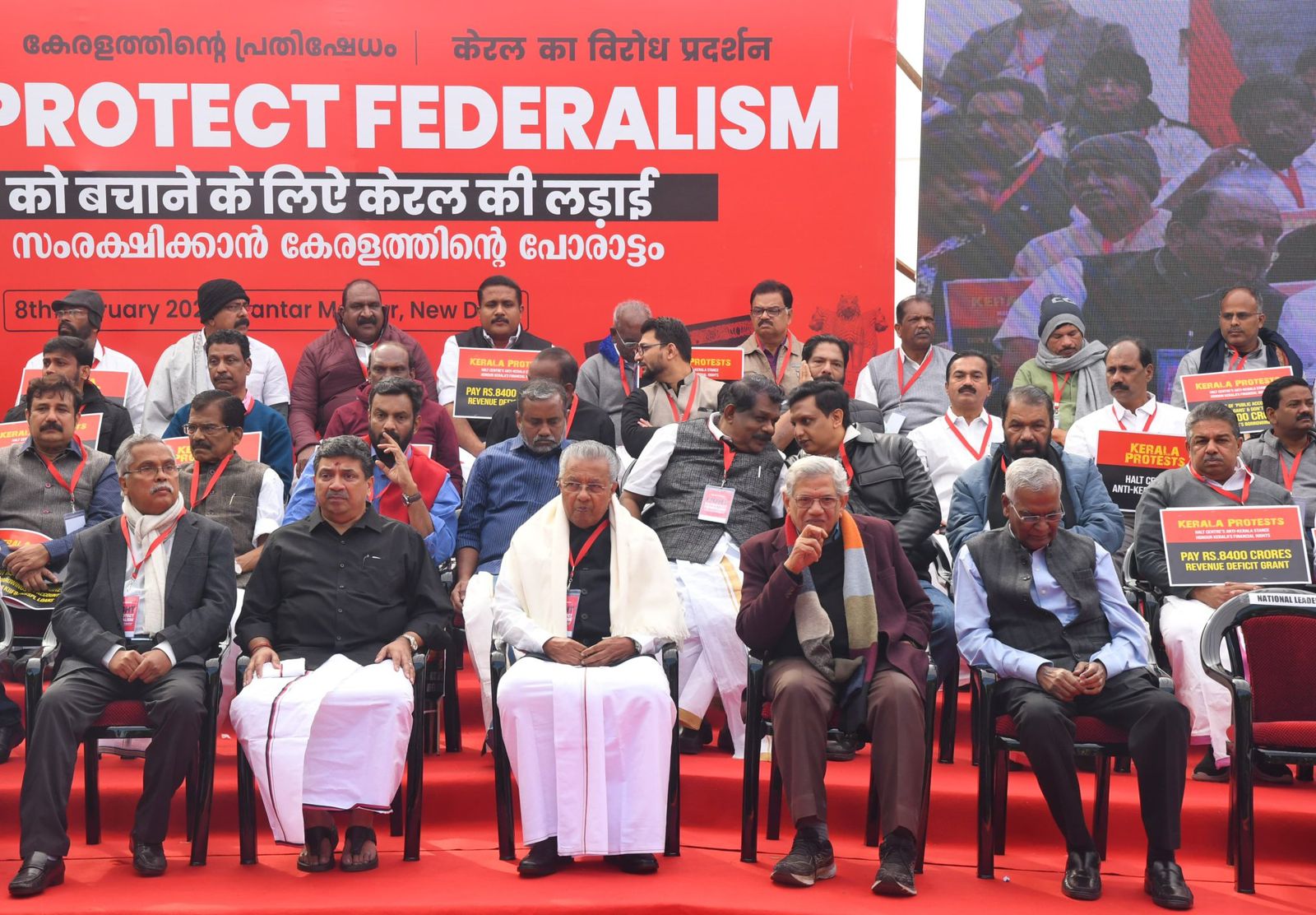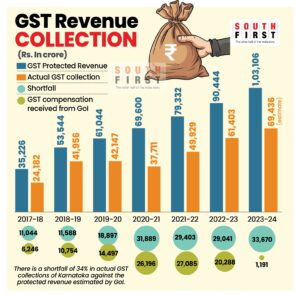South First brings to you a three-part series on fiscal federalism that explains why well performing states are accusing the Union government of fiscal injustice.

Oppositon leaders during the Kerala government's protest in Delhi. (Supplied)
Alleging fiscal injustice, southern States like Karnataka and Kerala have taken the fight for an equitable share of resources to the Union government’s doorsteps. With States like Tamil Nadu and Andhra Pradesh joining the chorus of the South Tax Movement, the demand to preserve fiscal federalism is growing stronger. South First brings to you a three-part series on fiscal federalism that explains why well-performing states are accusing the Union government of fiscal injustice. This report is the second part in the series and explains how the Southern States received consistently reduced funds from the Union government over five fiscals. You can read the first part that explains how much Southern states have contributed to the country’s revenues in the last five years here. You can read the third part that exposes the glaring gap in what Southern States give and what they get in return while Hindi-heartland states continue to get more funds despite reduced contributions here.
The day when Karnataka Chief Minister Siddaramaiah staged a protest at Jantar Mantar in New Delhi, alleging injustice in tax devolution and grants-in-aid from the Union Government, the Finance Minister Nirmala Sitharaman, thundered that “these claims come from a separatist mindset“.
She quoted Karnataka’s own data to “contradict” the state’s claim of injustice by insisting that the size of actual devolution had ‘increased’ since 2015-16.
However, the Union government’s data contradicts the Union Finance Minister. It shows that the percentage of tax devolution has, in fact, decreased consistently over the years.
The tax devolution—share in the divisible pool of Central Taxes and duties — released to five southern states put together has decreased from 17.98 percent in 2018-19 to 15.75 percent in 2022-23.
To understand this shift, one can analyse the percentage of the total amount shared with the Southern states in two different fiscal years—2018-19 and 2022-23—relative to the total amount shared with all states in each respective year.
The constant variable in this comparison is the total amount shared with all states, and the focus is on the percentage within that total.
Even in actual numbers, Karnataka received ₹35,894.83 crore in fiscal 2018-2019. It dropped to ₹21,694.11 crore in 2020-2021 and stood at ₹34,596.18 crore in 2022-2023 — lesser than the 2018-2019 share.
The conclusion is based on the written reply to an unstarred question of DMK MP P Wilson in the Rajya Sabha by Union Minister of State for Finance, Pankaj Chaudhary on 6 February.
The finance minister claimed that during the 14th Finance Commission (FC) five-year award period (2014-15 to 2019-20), Karnataka received ₹1,51,309 crore as tax devolution. She also claimed that the state will receive more during the 15th FC.
The Union finance minister however left out the fact that union budget size too increases every year and hence size of devolution too is expected to increase. Despite the supposed increase in size of devolution, southern states have seen reduced percentage as well as reduced funds over the last five years.
The Parliament answer from the finance ministry presents the facts. The proportion of funds allocated by the central government to South Indian states in comparison to the total amount distributed to all states has decreased for the former. This becomes evident when examining the proportion of the actual funds a state receives compared to the total amount shared by the Union government.
Between 2018-19 and 2022-23, Karnataka received ₹1,56,387.7 crore in tax devolution. However, the percentage of the amount shared with the state has declined. In 2018-19, the state received ₹35,897.03 crore; in 2022-23, the amount increased to ₹34,596.74 crore.
In 2018-19, the Karnataka’s share constituted 4.71 percent of the total amount meant to be distributed to all states, but by 2020-21, the share had decreased to 3.64 percent of the total amount.
Regarding Kerala, the finance minister stated that during the Congress-led UPA regime from 2004 to 2014, tax devolution amounted to ₹46,303 crore.
She noted a significant increase in this figure to ₹1,50,140 crore between 2014 and 2024 under the NDA government, representing a growth of 224 percent.
However, in the more recent period between 2018-19 and 2022-23, there was a decline in the tax devolution percentage for Kerala.
According to parliamentary records, the amount decreased from ₹19,038.17 crore in 2018-19 to ₹18,260.68 crore in 2022-2023. Consequently, Kerala’s tax devolution percentage reduced from 2.50 percent to 1.92 percent during this period, a decrease in both the absolute amount and the proportion of tax devolution that Kerala received compared to the total tax devolution to all states.
In addition, Over five years from 2018-19 to 2022-23, Andhra Pradesh experienced a reduction from ₹32,787.03 crore (4.30 percent) to ₹38,176.74 crore (4.02 percent). Telangana also observed a similar decline in percentage share, dropping from ₹18,560.88 crore (2.43 percent) to ₹19,668.15 crore (2.07 percent), a shift in the decrease in the proportionality of tax devolution among these states during the specified period.
Meanwhile, according to the finance minister, Tamil Nadu received ₹94,977 crore as tax devolution during the UPA regime. Under the NDA government, as of December 2023, this figure has increased significantly to ₹2,77,444 crore.
However, parliamentary responses revealed a minimal rise of 0.06 percent in Tamil Nadu’s tax devolution percentage, increasing from 4.02 percent to 4.06 percent between 2018-19 and 2022-23. In 2018-2019 Tamil Nadu’s share in central taxes was ₹30,638.87 crore and by 2022-2023 it was ₹38,731.24 crore
The Finance Minister asserted an increase in Grant-In-Aid provided by the union government to state governments for development, addressing regional imbalances and specific programs.
However, as per a parliamentary response by Pankaj Chaudhary in answer to CPI(M) MP John Brittas’ query, dated 1 August 2023, the two leading tax revenue-generating states in the southern region, Tamil Nadu and Karnataka, have witnessed a drastic decline in their Grant-in-Aid percentages compared to the total amount shared with all states, leading to a loss of revenue.
In the case of Karnataka, the proportion of Grant-in-Aid, which stood at 7.03 percent in 2018-19, has dwindled to 2.67 percent in 2022-23 (Budget Estimate). This decline translates to a notable decrease in the absolute amount as well, with the state receiving ₹ 34,479.54 crore in 2018-19 compared to only ₹22,281.01 crore in 2022-23 as Grant-in-Aid.
Similarly, Tamil Nadu has witnessed a reduction in Grant-in-Aid percentage from 5.66 percent to 4.77 percent between 2018-19 and 2022-23, contributing to a decline in the actual Grant-in-Aid received over the mentioned years.
Other Southern States have seen an increase in Grant-In-Aid from the union government over the last five years.
Parliamentary data paints a different picture despite allegations from the BJP of financial mismanagement by southern state governments and dependence on central revenue sharing.
The government data asserts that four Southern states demonstrate financial self-sufficiency, allocating over 50 percent of their Revenue Expenditure from their generated revenue.
In the fiscal year 2022-23, Telangana stands out by spending 70.60 percent of its own revenue on revenue expenditure, while Karnataka allocates a significant 67.37 percent. Tamil Nadu follows suit, dedicating around 55.72 percent of its revenue, and even Kerala, often criticised for financial mismanagement, expends 54.67 percent of its revenue.
The only exception is Andhra Pradesh, which slightly falls below the 50 percent threshold, spending 49.03 percent of its revenue in the same fiscal year.
Before July 2017, states had various avenues for revenue generation through their own set of taxes. The introduction of Goods and Service Tax (GST) in July 2017 aimed at uniformity in the tax structure nationwide.
To compensate states for any shortfall in their protected tax revenues under the GST regime, the Union Government assured that the shortfall would be covered from the introduction of GST compensation in 2017 to June 2022. On certain products, extra GST was levied by the union government to raise funds which can be given as compensation to the states for their shortfall.
This compensation is calculated based on the difference between the states’ current GST revenue and the protected revenue, considering an annual growth rate of 14 percent.

Karnataka Finance Ministry’s estimation of protected GST revenue versus actual GST collection. (SouthFirst)
States like Karnataka show that the shortfall between estimated protected revenues from GST and the actual collection was huge. Even after the end of GST compensation period, States have not been able to achieve the estimated protected GST targets leading to revenue loss.
The pandemic, in between, disrupted the promised five-year period of GST compensation, leading to a decrease in the cess imposed on certain products and an insufficient balance in the GST compensation fund.
In response, the Union Government initiated the provision of funds to states in the form of back-to-back interest-free 50-year ‘loans’. These loans aimed to assist states in bridging the resource gap caused by the delayed release of compensation due to the inadequate balance in the Compensation Fund. It’s noteworthy that these loans were accounted for as borrowings in the states’ books. The Union finance minister referred to these loans while addressing media and deeming Karnataka’s demand for fiscal justice “separatist mindset”.
As of the parliamentary answer dated 18 July, 2022, the Union Government has decided to continue the levy and collection of GST compensation cess until March 2026, but not extending the GST Compensation date. The extension of levy serves the purpose of repaying the back-to-back loans released to states in 2020-21 and 2021-22 in lieu of GST Compensation shortfall.
Additionally, it covers the payment of GST compensation for the month of June 2022 and arrears from previous fiscal years, based on reconciled figures from the Accountant General.
However, even after the initial fund release in the form of loans, the Union Government imposed conditions, including the requirement for states to name the schemes after them for further loans.
In a response to a starred question on the reasons for the state’s financial crisis, Kerala Finance Minister KN Balagopal, on 30 January, in the state legislative assembly said that the state was denied ₹3,000 crore in interest-free loans under the Centre’s Scheme for Special Assistance for Capital Expenditure 2023-24.
The denial of loan assistance was attributed to the state not adhering to guidelines related to branding and naming for five central government schemes. The schemes subject to mandatory branding are Swachh Bharat Mission (Gramin), Ayushman Bharat Health & Wellness Centres, Pradhan Mantri Awas Yojana (Urban), Poshan Abhiyan, and National Health Mission.
Similarly, Andhra Pradesh has been denied loans for the financial year 2023-24.

Jul 26, 2024

Jul 26, 2024

Jul 26, 2024

Jul 26, 2024

Jul 26, 2024

Jul 25, 2024